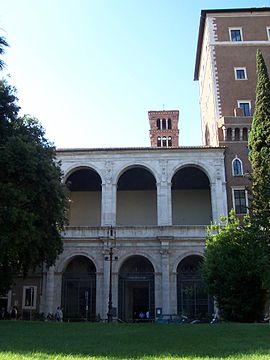
The Patriarch of Venice is the ordinary bishop of the Archdiocese of Venice. The bishop is one of only four patriarchs in the Latin Church of the Catholic Church. The other three are the Patriarch of Lisbon, the Patriarch of the East Indies and the Latin Patriarch of Jerusalem. Presently, the only advantage of this purely formal title is the bishop's place of honor in papal processions. In the case of Venice, an additional privilege allows the patriarch, even if he is not a cardinal, the use of the colour red in non-liturgical vestments. In that case, the red biretta is topped by a tuft, as is the custom with other bishops who are not cardinals.

The Basilica of St. Augustine in Campo Marzio, commonly known as Basilica of St. Augustine and Sant'Agostino, is a Roman Catholic titular minor basilica dedicated to Saint Augustine of Hippo. It is the mother church of the Order of Saint Augustine and it is located just northeast of the Piazza Navona in the rione of Sant'Eustachio in Rome, Italy.

The Basilica of Saint Praxedes, commonly known in Italian as Santa Prassede, is an early medieval titular church and minor basilica located near the papal basilica of Saint Mary Major, on Via di Santa Prassede, 9/a in rione Monti of Rome, Italy. The current Cardinal Priest of Titulus Sancta Praxedis is Paul Poupard.

Santa Cecilia in Trastevere is a 5th-century church in Rome, Italy, in the Trastevere rione, devoted to the Roman martyr Saint Cecilia.

The early Christian imperial basilica of the Saints Martyrs Vitale, Valeria, Gervasio and Protasio known more commonly as the basilica of San Vitale and Compagni Martiri in Fovea or more simply as San Vitale al Quirinale. It is the oldest Catholic place of worship in the historic center of Rome, located in via Nazionale. The imperial basilica of San Vitale al Quirinale, built under the pontificate of Pope Siricius after 386 and consecrated and richly decorated by Pope Innocent in 402 is the first public Christian basilica with a baptistery not founded on pre-existing pagan temples, mentioned in the Liber pontificalis, built by the Emperor Theodosius at the behest of Saint Ambrose of Milan, in honor of the miraculous discovery of the bodies of martyrs Gervasius and Protasius in Milan. It is the most frescoed basilica in Rome.

The Minor Basilica of St. Lawrence in Damaso or simply San Lorenzo in Damaso is a parish and titular church in central Rome, Italy that is dedicated to St. Lawrence, deacon and martyr. It is incorporated into the Palazzo della Cancelleria, which enjoys the extraterritoriality of the Holy See.

Santa Francesca Romana, previously known as Santa Maria Nova, is a Roman Catholic church situated next to the Roman Forum in the rione Campitelli in Rome, Italy.

The Roman Catholic Suburbicarian Diocese of Ostia is an ecclesiastical territory located within the Metropolitan City of Rome in Italy. It is one of the seven suburbicarian dioceses. The incumbent Bishop is cardinal Giovanni Battista Re. Since 1150, its bishop has been the Dean of the College of Cardinals. Its Cathedral is Basilica di Sant'Aurea.

Sant'Angelo in Pescheria or in Piscaria is a church in Rome. It dates from the 8th century. "In Pescheria" refers to its location close to the fish market built in the ruins of the ancient Porticus Octaviae.
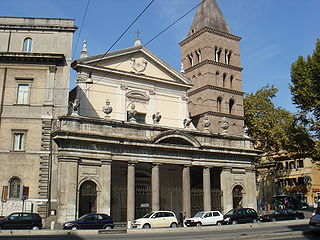
San Crisogono is a church in Rome dedicated to the martyr Saint Chrysogonus. It was one of the tituli, the first parish churches of Rome, and was probably built in the 4th century under Pope Sylvester I (314–335).
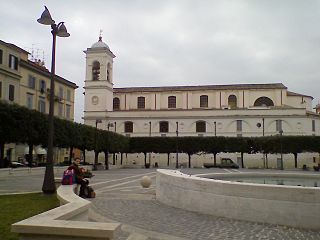
The Diocese of Albano is a Latin suburbicarian see of the Diocese of Rome in Italy, comprising seven towns in the Province of Rome. Albano Laziale is situated on the Appian Way some 15 kilometers from Rome.

The Suburbicarian Diocese of Palestrina is a Latin suburbicarian diocese centered on the comune of Palestrina in Italy.
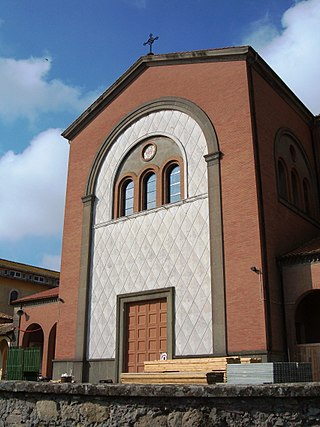
The Diocese of Porto–Santa Rufina is a Latin suburbicarian diocese of the Diocese of Rome and a diocese of the Catholic Church in Italy. It was formed from the union of two dioceses. The diocese of Santa Rufina was also formerly known as Silva Candida.

The Diocese of Frascati is a Latin suburbicarian see of the Diocese of Rome and a diocese of the Catholic Church in Italy, based at Frascati, near Rome. The bishop of Frascati is a Cardinal Bishop; from the Latin name of the area, the bishop has also been called Bishop of Tusculum. Tusculum was destroyed in 1191. The bishopric moved from Tusculum to Frascati, a nearby town which is first mentioned in the pontificate of Pope Leo IV. Until 1962, the Cardinal-Bishop was concurrently the diocesan bishop of the see. Pope John XXIII removed the Cardinal Bishops from any actual responsibility in their suburbicarian dioceses and made the title purely honorific.

The Suburbicarian Diocese of Velletri–Segni is one of the Latin suburbicarian dioceses, Catholic dioceses in Italy close to Rome with a special status and a cardinal bishop, the bishop of Velletri–Segni. Historically, the see of Velletri was combined with the see of Ostia from 1060 to 1914.

The Diocese of Padua is a Latin diocese of the Catholic Church in Veneto, northern Italy. It was erected in the 3rd century. The diocese of Padua was originally a suffragan (subordinate) of the Patriarchate of Aquileia. When the Patriarchate was suppressed permanently in 1752, it became a suffragan of the Archdiocese of Udine. In 1818, when the dioceses of northern Italy were reorganized by Pope Pius VII, it became a suffragan of the Patriarchate of Venice, and remains so today.
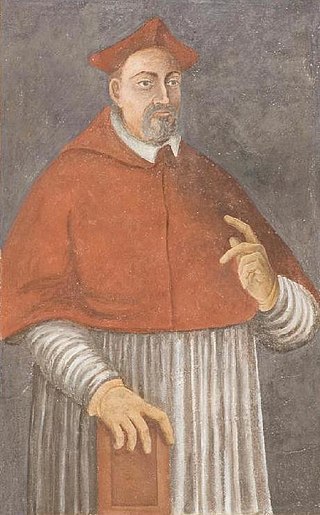
Francesco Pisani was an Italian Cardinal, born in Venice, the son of Alvise Pisani the noted banker, who was Procurator of S. Mark's, a member of the Council of Ten, and a Councilor of the Doge of Venice; and Cecilia Giustinian. He had a brother named Giovanni (Zuan), who also became Procurator of S. Marks' and was a Venetian diplomat; he was married to the sister of Doge Andrea Gritti. He was a strong supporter of the alliance between Venice, France and the Papacy, called the League of Cognac. He shared the imprisonment of Pope Clement VII in the Castel S. Angelo during the Sack of Rome and its aftermath. He spent eighteen months in exile in Naples while Clement made his peace with the Emperor Charles V.

The Diocese of Tivoli is a Latin Church ecclesiastical territory or diocese of the Catholic Church in Latium, Italy, which has existed since the 2nd century. In 2002 territory was added to it from the Territorial Abbey of Subiaco. The diocese is immediately exempt to the Holy See.
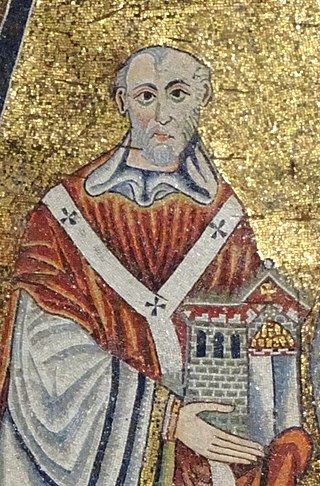
The 1130 papal election was convoked after the death of Pope Honorius II and resulted in a double election. Part of the cardinals, led by Cardinal-Chancellor Aymeric de la Chatre, elected Gregorio Papareschi as Pope Innocent II, but the rest of them refused to recognize him and elected Cardinal Pietro Pierleoni, who took the name of Anacletus II. Although Anacletus had the support of the majority of the cardinals, the Catholic Church considers Innocent II as the legitimate Pope, and Anacletus II as Antipope.
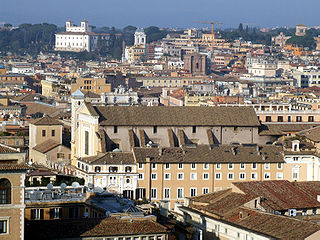
Santi Dodici Apostoli, commonly known simply as Santi Apostoli, is a 6th-century Roman Catholic parish and titular church and minor basilica in Rome, Italy, dedicated originally to St. James and St. Philip, whose remains are kept here, and later to all Apostles. Today, the basilica is under the care of the Conventual Franciscans, whose headquarters in Rome is in the adjacent building. It is the Station church for Friday, the first week of Lent.
